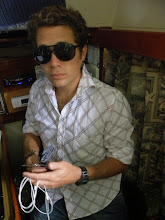My short-lived residence in the Darkside was pleasant, its lukewarm chills mitigated by a self-awareness (one would hope) of its own inanity. Now that I've returned to the lands where telephones do not indiscriminately murder, witchmen still lack the secret of transmigration of the soul, and mannequins remain in whatever poses they are left, I don't foresee myself myself day-tripping back to the Darkside on another hangover Saturday afternoon.
Let me afford you a brief description of the program. Each episode begins with a repetition of synth notes played over stock footage of blue skies, farmhouses, bridges, and forests, accompanied by a narrator's explanation (a monologue written by producer George Romero) of the duality of reality (light and dark sides). As the narrator horrifyingly enunciates, the better illuminated, more tranquil scenes of nature flip to--chillingly--A STILL IMAGE OF A TREE IN SHADOW. Over this spine-tingling picture is laid the Tales from the Darkside title screen, which recurs, in '80's television fashion, before and after each commercial break. Lest we forget the cornball TV series for which we've surrendered a half-hour of our lifespan.
With a few exceptions, there seem to be three kinds of stories repeated throughout Tales from the Darkside: 1) inanimate objects gain sentience (generally malevolent) that bodes ill for the human beings who encounter or come into possession of them; 2) a hapless experimenter of black magic is inevitably doomed to suffer for transgressions into the spirit world; 3) an otherwise normal person comes into contact with the mythical or otherworldly, with (surprisingly) happy results.
In the first first category (what seems to be the most frequently featured), a man takes home a store mannequin he imbues with the characteristics of his parted wife, and she kills him in front of his friend; a woman, investigating why a telephone next door to her hotel room won't stop ringing, is strangled by the evil phone's cord; a man purchases an answering machine that sabotages his life with messages he never intended; a woman is lied to and later absorbed into a fortune telling machine.
In the second, a physically repulsive medicine man is poisoned by his wife and young lover, only to plant his soul in the young man's body before he dies; a man uses black magic to win the lottery, but is foiled by a stronger agent of the dark arts.
In the third kind of story, which always struck me as the most bizarre and unsatisfying, the Gorgon Medusa is liberated from her mannequin state (mannequins again!) by an unfortunate burglar who looks into her uncovered eyes, and later finds love with a blind saxophone player in a New York subway station; a man collects the tears of a clinically depressed woman, and adds these tears to his storage room of sadness through the ages--when she steals her tears back and breaks the vial that contains them (she's almost run down by a taxi), she's set free from sadness.
Some of the actors who have appeared in Tales of the Darkside, who have appeared in the shows described above, may raise one's eyebrows. Jerry Orbach plays the friend of the mannequin obsessive, Harry Anderson is the unlucky bum under the control of his answering machine, and, in an unlikely pairing, Bud Cort and Carol Kane engage in supernatural warfare to possess a winning lottery ticket. And a very young Victor Garber is the Collector of Tears, a far cry from his work as Jack Bristow in Alias. The acting is usually bad, given the expectations we may have of some of these performers.
Likewise, the budget is low, and the direction--in fact, the whole feel of the enterprise--reminds one of the instructional videos one was compelled to watch when starting a new job. The lack of any discernible slickness, though, is refreshing.
At times, in its quest of wringing meaning from its cheap stories, Tales from the Darkside manages to synthesize an utterly different kind of television that goes against everything we, with our preoccupation with continuity and extended plot lines and closure in our modern TV serials, are used to. The show has a lot of information to get across in its 20 plus minutes, and at times does so in ways completely unforeseen. For instance, the episode with the killer telephone is primarily enacted in a long, overblown monologue by a conceited actress (played by a less conceited actress). When Medusa comes back to life, rather than rampage about the earth, she discusses forgiveness, love, and the inherent flaws of human nature. And the one about the fortune telling booth (the best of the episodes, technically) has something powerful to say about destiny and ideological inflexibility, and puts this forth (all credit to the actors) with the intensity of a one-act play.
Enjoying Tales from the Darkside, when I had access to the series, is like enjoying certain Hostess products. It does not necessarily taste good, nor is it good for you--but there is something comforting in its ability to remind you of simpler times. When this sort of thing was consumed with no discretion whatsoever.

No comments:
Post a Comment